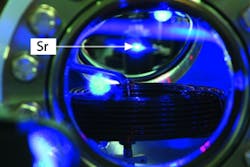Optical strontium clock is now better candidate for 'new' second
Braunschweig, Germany--Scientists at the Physikalisch-Technische Bundesanstalt (PTB) have measured the influence of the ambient temperature on strontium atoms for the first time, potentially reducing the measurement uncertainty of optical strontium clocks by one order of magnitude.1 Such clocks, which use neutral strontium atoms as the frequency generator, are considered one of the top candidates for the definition of a "new" second.
Previously, the influence of the ambient temperature could only be derived theoretically. The PTB results might well spark interest also in geodesy and in fundamental physical research (helping to answer the question as to whether fundamental constants such as the fine-structure constant are really constant).
Due to the higher frequency of optical radiation, optical clocks are more accurate than microwave clocks, which are currently used in the form of cesium atomic clocks to "produce" the second. In an optical strontium clock, a cloud of neutral strontium atoms is cooled down in two steps by means of laser radiation until the atoms exhibit a speed of only a few centimeters per second. An optical lattice ensures that the atoms are trapped.
Ambient temperature the problem
Unfortunately, strontium atoms react relatively strongly to changes in the ambient temperature; their atomic levels are then shifted in energy, which causes the clock to become inaccurate. This is the greatest contribution to the uncertainty of this type of clock.
To measure this phenomenon, the PTB scientists amplified it by using a static electric field rather than the alternating electromagnetic field of blackbody radiation. They constructed a parallel-plate capacitor whose electric field is known to a few-tens-ppm accuracy. For this purpose, the distance between the two plates, which amounted to 0.5 cm, may only vary by a few 100 nm over its length of 7 cm; the same applies to the accuracy of the distance.
The PTB scientists measured the influence of electromagnetic fields on the two decisive (for their clock) eigenstates in the strontium atom. In this way, they determined its uncertainty contribution to the total measurement uncertainty to 5 x 10-18. Because just this influence had, to date, been the most restrictive influence on the total measurement uncertainty, one can expect the next frequency measurements of the clock as a whole to lie well below the previously attained 1 x 10-16.
REFERENCE:
1. Middelmann, T. et al., Physical Review Letters, 109, 263004 (2012) http://prl.aps.org/abstract/PRL/v109/i26/e263004

John Wallace | Senior Technical Editor (1998-2022)
John Wallace was with Laser Focus World for nearly 25 years, retiring in late June 2022. He obtained a bachelor's degree in mechanical engineering and physics at Rutgers University and a master's in optical engineering at the University of Rochester. Before becoming an editor, John worked as an engineer at RCA, Exxon, Eastman Kodak, and GCA Corporation.
